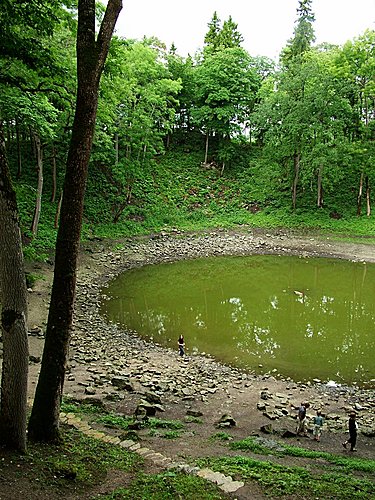Eighteen kilometers from Kuressaare towards Kuivastu is the location of Estonia's most unique geological object, Kaali lake.

Early explorers considered the ring-shaped Kaali crater as a volcanic depresion or a karst hole formed due to the dissolution of limestone, gypsum or salt. The meteoric origin of the lake basin was first suggested by J. Kalkun-Kaljuvee in 1922. In 1937 Ivan Reinvald collected 30 fragments of meteoritic iron from the collateral craters. The analysis of the fragments showed that the cosmic body which fell to the Kaali area belonged to the most frequent type of iron meteorite, coarse octahedrite, with the contents of Fe and Ni amounting to 91.5 and 8.3%, respectively.
The structure of the craters and the distribution of meteoritic material suggest that the meteorite fell from the east-northeast at an angle of 45 deg. The initial mass of the meteorite could have been 400 to 10 000 tons, mass at impact was 20 to 80 tons, initial velocity upon entering the atmosphere was 15 to 45 kilometers per second, velocity at impact ranged from 10 to 20 kilometers per second.
By passing through the atmosphere the meteorite heated and broke into pieces at an altitude of five to ten kilometers, falling to Earth as a meteorite shower. As a result, the main crater, 110 meters in diameter and 22 meters in depth, and at least eight collateral craters with a diameter of 12 to 40 meters and a depth of one to four metes, were formed.
The craters or their embankments do not contain marine sediments. Therefore the craters cannot be older than the time the area emerged from the sea. The explosion scattered into the air abundantly fine particles of soil and rock, which by melting formed glassy spherules. These spherules have been found in mires and lake sedimets in the vicinity of the craters. The age of the layers of peat with microimpactites is 7500 to 7600 years, which is the most probable age of the Kaali craters.
In the main crater there is a natural body of water that is known as Lake Kaali. Its diameter, ranging from 30 to 60 meters, depends on the water level. Its depth is one to six meters. The lake is fed by ground water and precipitation. The bottom sediment layers are about six meters thick and up to 4 000 years old.
Kaali crater can be compared with the world's best known and youngest craters, as follows:
Crater nr. 1 is approximaterly 300 meters northwest from the main crater and is the largest aside from the main crater. Today it is a brush-filled depression four meters in depth and 39 meters in diameter.
Craters nr. 2/8 are twin craters. They are located about 600 meters south from the main crater, on a flat hillock. Nr. 2 crater's north diameter is 25 meters and southside diameter 76 meters, its depth is 3.5 meters (the depression is clean of brush and can be easily observed). This is the crater from which I. Reinwald found the first pieces of meteor in 1937.
Crater nr. 3 is 250 meters east from the previous one. This is the best preserved of the dry depressions. Its diameter is 33 meters and its depth is 3.5 meters.
Crater nr. 4 is on the north side of the Kaali to Kõljala road, 300 meters east of the main crater. Its diameter is 20 meters and the depth is 1.25 meters. This craters is almost no longer discernible.
Crater nr. 5 is 170 meters south from the previous one. Its original diameter was 13 meters and its dpeth .9 meters. This crater has yielded the largest number of meteorite pieces, including the largest one found, which weighed almost 40 grams.
Crater nr. 6 is 450 meters northwest from the main crater. This is a barely discernible depression, by the side of the road. Its diameter is 26 meters and its depth is .6 meters.
Crater nr. 7 is located opposite the Kaali store. That this is a meteorite crater was only discovered in l965. Its measurements are 15 meters diameter and one meter in depth.
Crater nr. 9 is 100 meters northwest from crater nr. 6. Its diameter is 12 meters and its depth is almost one meter.
It is not impossible that there are as yet undiscovered meteorite craters. Since the meteor fell as a meteor shower, this is probably more than likely. But the smaller depressions have been filled with rocks and soil by the local farmers, and they have melted into the landscape.
The following actions must be completed to succesfully log this Earthcache.
1) Why are no metereotic fragments found in the main crater?
2) What was the initial mass of the meteorite and what was the mass at impact?
3) Optional but not required: make a picture of yourself together with your GPS near the main crater and add this picture to the log.
From the guidelines: "People do not need to wait for permission to log your EarthCache. Requiring someone to wait is not supported by the EarthCache guidelines. People should send their logging task answers to you, then log your EarthCache. When you review their logging task answers, if there is a problem, you should contact them to resolve it. If there is no problem, then their log simply stands."

